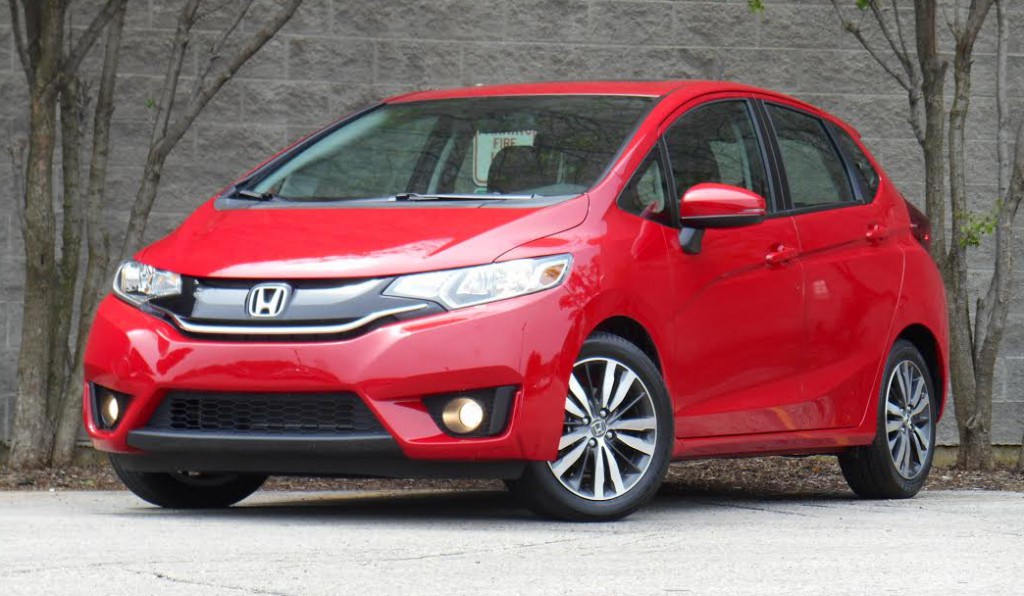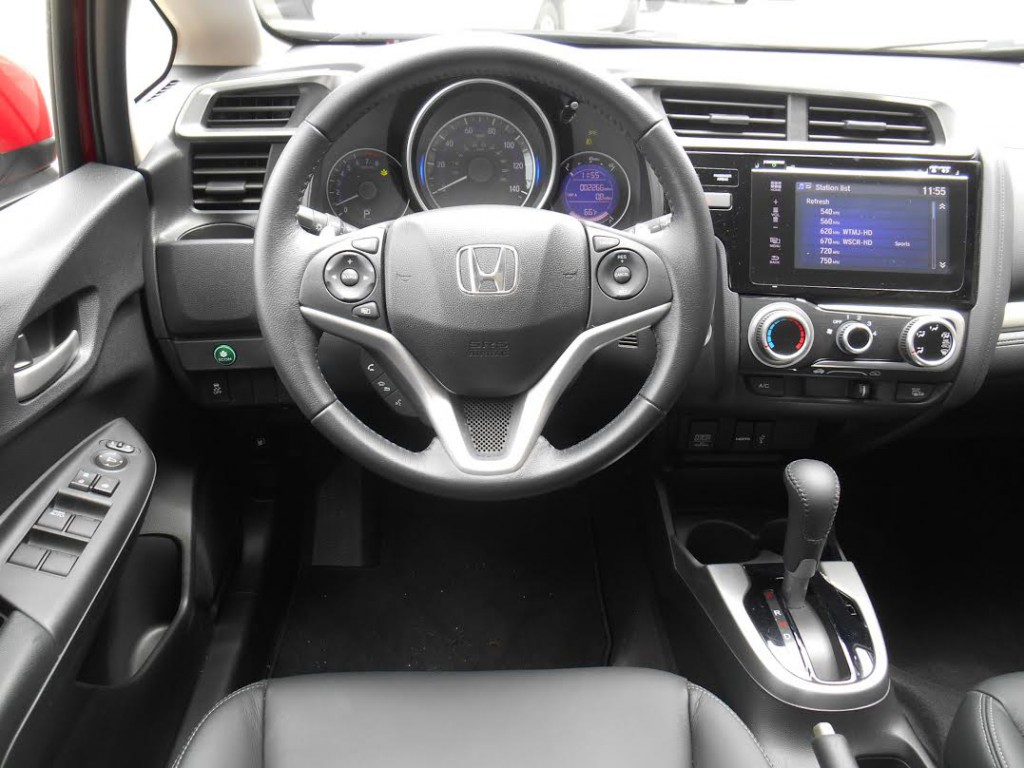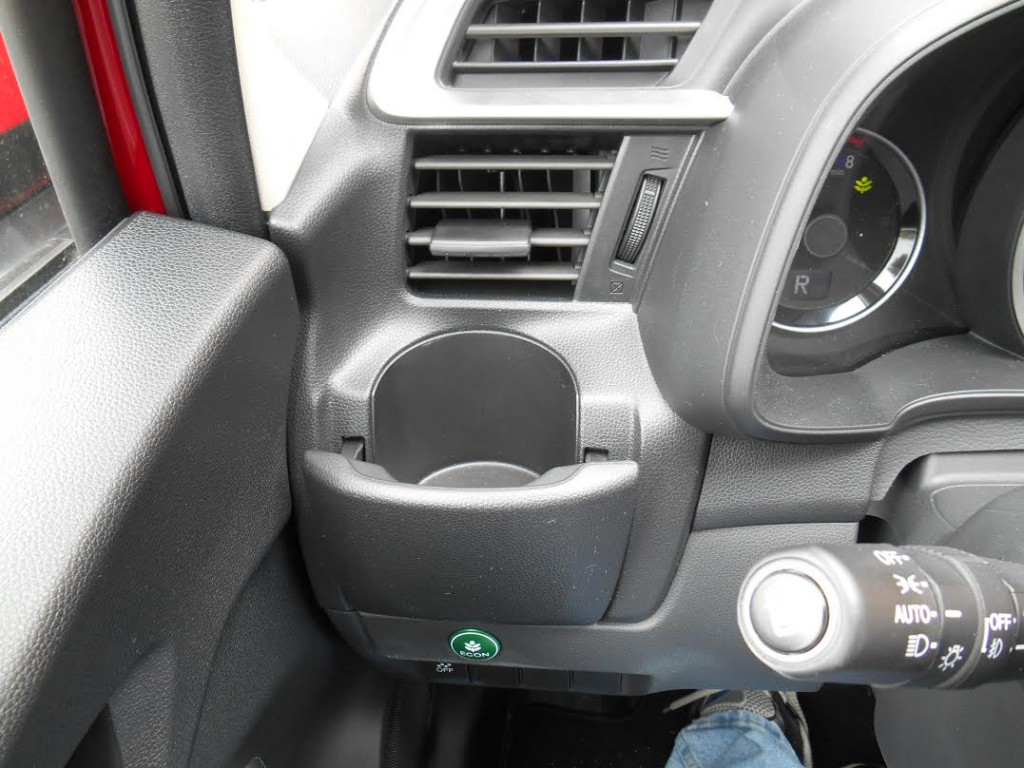
2015 Honda Fit EX-L Automatic with Navigation
Miles Driven: 276
Fuel Used: 9.0 gallons
Real-world fuel economy: 30.7 mpg
Driving mix: 70% city/30% highway
Base price: $$20,800 (not including $790 destination charge)
Price as tested: $21,110
Quick Hits
The great: Roomy, pleasant cabin; room for adults in back
The good: Flexible storage options allows plenty of space for cargo and passengers
The not so good: No surplus of merging, passing power
John Biel
After having taken a model year off in 2014, Honda’s subcompact hatchback is Fit-ting back in the lineup for 2015. Not surprisingly, it has been fully redesigned and substantially reengineered.
The new Fit looks less like a tiny minivan, as it did in its previous 2 generations, and more like a diminutive wagon. It has picked up some power and been packed with more of the electronic gadgetry that shoppers have come to expect in just about every new vehicle these days.
When last seen, the Fit’s 1.5-liter 4-cylinder engine was making 117 horsepower driven through a choice of 5-speed manual or automatic transmissions. The new model has the same engine displacement, but power has been bumped up to 130 horses, and transmission selections include a 6-speed manual or continuously variable (CVT) automatic.

All 3 trim levels of the 2015 Fit use this engine. Consumer Guide® tested the top-end EX-L, which comes only with the CVT. Not being overly endowed with torque (114 lb-ft at 4600 rpm), the Fit moseys away from stoplights, and does a merely adequate job of merging onto expressways and passing. The stepless CVT doesn’t particularly aid this process as the engine struggles with a mighty groan the whole time that it is fighting to reach cruising speed.
2015 Honda Fit: Adding Value to Versatility
CVT-equipped Fits operate in either “Econ” or “Sport” mode. The difference is accomplished by changing fuel delivery. If you make the change on the fly, you can hear the revs pick up a bit and see a slight blip on the tachometer when going into Sport, but the overall difference is hardly night-and-day. This tester drove the Fit for 196.7 miles—65 percent of that under city conditions, and with a mix of Econ and Sport driving—averaging 33.55 mpg.
Tidy dimensions and responsive electrically assisted rack-and-pinion steering make the Fit a fairly nimble handler with a bit of body lean in cornering. Though overall length has been pared slightly, wheelbase has been extended to 99.6 inches, which helps stabilize the ride in what’s a pretty small car—though serious surface imperfections will register in the cabin.
CG’s sample car was an EX-L with the navigation system, which points up the increased level of electronic convenience and entertainment fit into the Fit. It appears on a 7-inch touch screen and includes voice recognition, high-definition digital traffic information, and customizable feature settings, plus high-definition radio and satellite radio. Audio settings have to be selected on the screen, but climate controls that are easy to reach and use exist as rotary dials under the screen. All the expected techno bells and whistles—HondaLink infotainment system, Pandora radio compatibility, Bluetooth audio streaming, USB and MP3-device ports—are standard, too.
Five Neat Things (and a Couple of Downers) About the 2015 Honda Fit EV
Passenger room is a pleasant surprise for a subcompact. Sitting behind the driver’s seat as set for this tester’s 5-10.5 frame left plenty of leg room for an adult, which suggests that a taller front-seat occupants could take up a little more space before starting to squeeze out rear passengers. Head room is good front and rear, and visibility is excellent in practically any direction. Seats offer decent support and long-haul comfort. In order to maximize rear cargo space, Honda has moved the Fit’s fuel tank to a location under the front seats. A gradual rise in the floor pan to accommodate this has the perhaps-unintended benefit of creating an angled foot rest for rear-seat occupants (which will number 2 adults or 3 kids).

With the rear seats up, the flat cargo floor isn’t especially deep, but its low installation makes the most of what’s there. The 60/40 folding rear seats don’t fold completely flat, but covering panels provide a smooth transition, protecting seats and cargo from possible damage. Also, the rear seat cushions can be flipped up to open up a floor-level load space that runs the width of the car. The front-passenger seat back retracts, so when the right-rear seat is lowered, especially long items can be carried.
Personal-item storage isn’t quite as generous. While the glove box is larger than in some bigger cars, door pockets are small, especially in the rear doors. A small covered bin sits at the back of the center console. (Worse yet, the bin cover doesn’t sit high enough to serve as an effective center arm rest.) There’s a storage pouch on the back of the front passenger seat, but not behind the driver’s seat.
Fit prices start at $15,525 for the manual-transmission LX, but rise to $20,800 for the EX-L with navigation. (Skipping the nav unit saves $1000). Delivery adds another $790. Aside from across-the-board standards, EX-Ls feature steering-wheel-mounted paddle shifters, heated power side mirrors with integral turn-signal blinkers, a leather-wrapped steering wheel and shifter knob, and heated leather-trimmed seats that, frankly, don’t come off as all that sumptuous. However, this little Honda is more about utility and economy, and that’s why it can be a good Fit for a lot of small-car shoppers.
Tom Appel
Moving Fit production from Japan to Mexico gives Honda a little more money to spend on product, money that would have otherwise been spent on transportation and lost on currency fluctuations.

That “found” cash has been put to very good use. In almost every way the new Fit is a better vehicle than the old one. It’s quieter, smoother riding, better appointed inside, and just generally more pleasant to spend time in.
Why the New Honda Fit EV is the Best Electric Car You Can’t Buy
Oddly, despite the added power (up 13 horsepower to 130), the 2015 Fit doesn’t feel as lively as the outgoing version. This is my seat-of-the-pants impression, and it’s possible that since I am hearing less from the engine bay, it feels as if less is going on.
Honda has for years limited the number of Fits it imported to the U.S., this because it wasn’t really making any money on them. This changes for 2015, and it’s very likely we’re going to see a lot more of these likable and practical small Hondas on the road very soon.
Damon Bell
Like the previous-generation Fits that came before it, the biggest strength of the redesigned 2015 Honda Fit is its outstanding passenger/cargo space and versatility. It’s easily one of the most space-efficient vehicles on the market, delivering better all-around interior room than even some compact cars and compact SUVs. I can fit my 6’6” frame into the back seat with no problem, even when the front seats are adjusted all the way back (wouldn’t want to sit there for a cross-country trip, but I’d be fine on a short drive). For most average-height folks, the Fit’s rear seat will be more than adequate.
The Fit’s relatively tall, upright seating position makes for easy entry and exit and allows for a fairly commanding view from the driver’s seat. Despite the Fit’s diminutive exterior dimensions, I didn’t feel dwarfed by surrounding traffic. Plus, that tiny footprint–along with the nimble chassis and quick, responsive steering–make the Fit quite enjoyable to drive. It’s fun to toss into quick corners, and it is obviously very maneuverable in tight quarters.
The Fit still has faults, however. Despite a solid, substantial-feeling body structure, the ride can get stiff in a hurry once you encounter potholes, large bumps, and/or rough pavement. The interior looks quite nice, but it’s mostly hard plastic; my elbows and I wished for more padding on the center console armrest and the tops of the doors. I found the touchscreen audio system to be a pain. The only real, non-virtual button is the audio power button, and the virtual volume controls are difficult to use, especially when the car is moving. At least there are steering-wheel controls for the stereo volume.
Despite these shortcomings, the new Fit makes a lot of sense, especially for city dwellers who need a lot of space in a small package.


